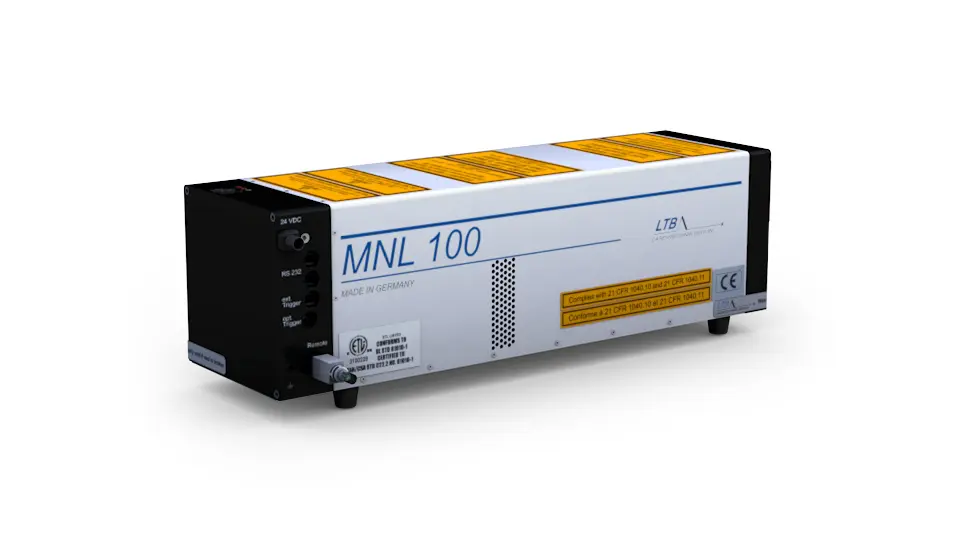
MNL 100 – The Marathon Nitrogen Laser
LTB Lasertechnik Berlin announces the series launch of a new mini-nitrogen laser, named MNL 100. This is a UV laser designed for industrial use. Its dimensions are (296 x 95 x 95) mm. It is modular, compact, robust, and economical. The individual modules can be easily and quickly replaced in the event of service needs.
For the first time, a directly switching semiconductor module is used for the high-voltage circuit. It operates without wear and allows excellent synchronization. The sealed tube has a lifespan of more than 60 million pulses (2 years warranty). A special beam path inside the laser tube ensures a homogeneous and symmetrical intensity distribution of the laser beam.
The functions of the laser are controlled and monitored by an integrated controller. An integrated energy monitor allows the laser to operate with constant pulse energy over the specified pulse count. The maximum repetition frequency is 60 Hz. The pulse width is 3.5 ns, and the pulse energy exceeds 100 µJ.
The laser is also available in a low-divergence version (0.5 mrad) as the MNL 100 LD. Optionally, the laser can be equipped with fiber coupling. The main applications of the MNL 100 include laser-induced fluorescence spectroscopy (LIF), MALDI-TOF mass spectrometry, and laser microdissection.
LTB Lasertechnik Berlin gibt den Serienstart eines neuen Mini-Stickstoff-Lasers mit dem Produktnamen bekannt. Es handelt sich um einen UV-Laser für den industriellen Einsatz. Seine Abmaße sind (296 x 95 x 95) mm. Er ist modular aufgebaut, kompakt, robust und wirtschaftlich. Die einzelnen Module lassen sich im Servicefall leicht und schnell austauschen.
Erstmalig wird zur HV-Schaltung ein direkt schaltendes Halbleitermodul eingesetzt. Es arbeitet verschleißfrei und ermöglicht eine exzellente Synchronisation. Die abgeschlossene Röhre besitzt eine Lebensdauer von mehr als 60 Millionen Impulsen (2 Jahre Garantie). Eine spezielle Strahlführung in der Laserröhre sorgt für eine homogene und symmetrische Intensitätsverteilung des Laserstrahls.
Die Funktionen des Lasers werden über einen integrierten Controller gesteuert und überwacht. Ein integrierter Energiemonitor gestattet es den Laser mit konstanter Impulsenergie über die oben angegebene Impulszahl zu betreiben. Die maximale Folgefrequenz ist 60 Hz. Die Impulsbreite liegt bei 3,5 ns und die Impulsenergie ist größer als 100 µJ.
Der Laser ist auch in einer niedrigdivergenten Version (0,5 mrad) als MNL 100 LD verfügbar. Optional wird der Laser mit einer Fasereinkopplung ausgerüstet. Hauptanwendungsgebiete des MNL 100 sind die laserinduzierte Fluoreszenzspektroskopie (LIF), die MALDI-TOF Massenspektrometrie und die Laser-Mikrodissektion.

